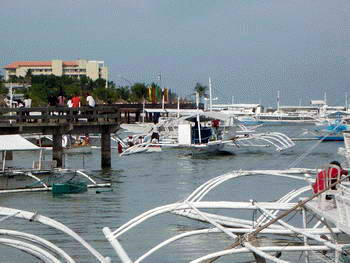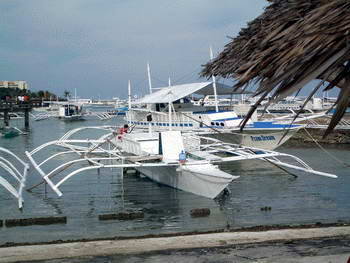The
one thousand gallon sump area
The bank of thirty ultra violet
units
I of course was keenly interested in the
appearance of the livestock and spent quite a bit of time looking for
any signs of disease or stress. Much to my surprise, it appeared to me
that all the fish looked and behaved as if they felt quite at home. All
the fish looked healthy and relaxed, and try as I may, I could not find
a single dead fish in the system, not even a damaged fin could be seen.
I would have gladly purchased any one of the thousands of fish being
kept. Believe me, it was a hard temptation to resist and not go home
with a bag full of fish myself. I had also assumed that any fish that
were unable to be sold or shipped immediately were kept until an order
came in for that particular species. Peter assured me that if any fish
are unable to be moved within a reasonable amount of time, they are
then released back into the ocean, and not just any part of the ocean.
A very nearby ocean front hotel has a large area of the reef in front
of the hotel roped off and does not allow fishing or collecting to be
done in that area as a means to ensure their guests always have a
pristine reef populated with alot of fish to enjoy as they snorkel or
scuba dive. It is within that protected area that all of the fish Peter
returns to the ocean are put. Again, all this is done as a means
to reduce stress and fish losses. Right after my visit to the facility,
I enjoyed a short swim and followed Peter's recommendation that I swim
around the point and see for myself the roped off area he had
mentioned. I did so, and was again a bit surprised to see the
difference between the protected area and the not protected area. The
reef structure and life within the protected area was vastly
greater than outside of the protected area. There are no nets to keep
the fish within that zone, yet by noting the population densitys between the
two areas, it was as if there was a visible line that the fish knew not
to cross. I attribute that to the reef structures being in much better
condition thus providing a much better environment that the fish would
prefer.
 Roped off area that most resorts use to create a protected area for their guests.
Roped off area that most resorts use to create a protected area for their guests.
Once I had been shown around and given a chance to
get over my initial excitement of being in a room filled with hundreds
of species of fish, my conversation with Peter turned towards the
supply chain the livestock must go through to reach the hobbyist. I
told Peter that I was very relieved to see that my preconceived notions
of an export facility had turned out to be wrong. Again, Peter
emphasized to me the importance of keeping stress to an absolute
minimum, something we as hobbyists can take away and apply to our own
husbandry methods. For those not versed in fish pathogens, the largest
underlying cause of fish health problems are all in relation to their
stress levels. Providing a clean, well aerated and properly stocked
aquarium will go a very long way in ensuring that your aquatic pets are
with you for a very long time.
As Peter described the shipping routes and stop overs the
fish must endure, it quickly became apparent that any one of the
destinations can easily destroy all others preventative efforts if the
livestock are not given the proper environment and time to regain from
the unavoidable stress' of travel. Time of course is a critical factor
since even with a supplier's best efforts and equipment, a shipping bag
or container can only act as a very short lived environment. Any delay
along the way greatly increases the stress levels of the fish. While
the industry has greatly improved since my days of being a fish shop's
manager, there will always be unavoidable stress upon the fish, which
means that by the time a local fish shop receives the fish, their
stress levels will be at their highest, and equates into their being at
their most vulnerable. This is where the fish shop must do all that it
can to quickly reduce stress and isolate the newly arrived fish.
Anyone who is either a hobbyist forum or club member has
surely heard the numerous accounts of newly purchased fish being
brought home only to die within a matter of days or infect an entire
show aquarium with any number of possible pathogens. All of which can
be linked directly to how the fish were handled and the stress' they
were subjected to. Since the exporters are the first link in the chain,
their efforts will of course determine the stamina the fish have to
endure their travels. From my observations at Peter's facility, that
critical first link has been taken care of.
Sadly, all the efforts of any one link can be for naught
if the fish arrive at a store only to be unpacked and unceremoniously
dumped into a display tank and put up for immediate sale. When visiting
a shop with the intent to purchase a new pet, I would ask that you
inquire as to the shop's stress reduction procedures for newly arrived
livestock and how they control pathogens. If none exists, I would
be very leary in purchasing a pet that has not been given the chance to
recuperate and ensured to be pathogen free as any fish subjected to
stress will be much more easily infected / infested. This will not
negate your responsibility to do the same for a newly purchased fish as
well. As hobbyists, we should also do all that we can to provide the
proper habitat for each species that you keep and ensure that all newly
acquired pets are quarantined with stress reduction being at the
forefront of your efforts. There are many good articles available
online detailing handling and quarantine procedures. If you are not
familiar with such procedures, I believe you owe it to your new pet to
become so. From what I have observed, the fish do get off to a good
start, please do your best to ensure that they have a happy end to
their journey as well.


Maribago Harbor and the boats used to access the offshore reefs.










